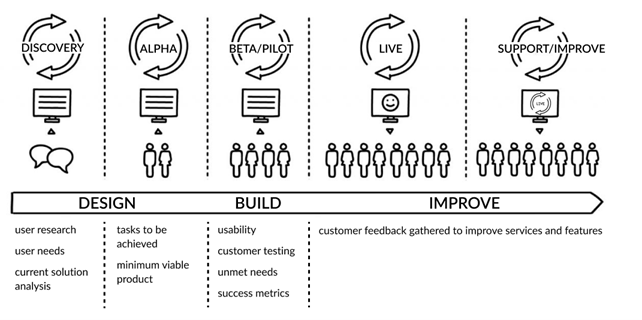Understand user needs
Understand user (customer) needs. Research to develop a deep knowledge of the users and their context for using the service.
- Identify current and prospective users of the service. Use existing research to understand their needs.
- Plan a user research approach that suits your project. Gather qualitative and quantitative evidence. Decide how you will analyse and use your insights.
- Design for the user journey. Group and prioritise pain points and develop hypotheses about these pain points.
You need to understand the people who use your service (your users) and what they want to do (their user needs) to build a service that works for them. You need to understand users and their needs from their point of view and not solely through the lens of the project you have been tasked with.
To do this, you will need to really understand what users are trying to do when they encounter your part of the service and you need to design services that address that context. This will often involve understanding things that are not in scope or part of your responsibility so that you can design better services.
You will need to understand all aspects (end to end and across channels) of your users current experience. Users should include everyone who is involved in the service delivery: end users, public servants delivering the service and other intermediaries who support end users to access the service.
Your user research needs to cover a wide range of users and show that you understand how different user scenarios may impact service design and delivery. You must include from the earliest stages users who may need assistance to interact digitally or are unable to interact digitally at all.

In Discovery and Alpha stages
During the Discovery stage and Alpha stage the team should have spent a time with end users and learned about their needs. The depth of your research should reflect the scale and nature of the digital service.
You should understand and be able to show evidence to demonstrate the following:
Who are the users?
What about the users motivations, triggers, contexts are significant for your service?
How can you find the users to invite them to participate in user research? You should include users with varying needs (such as needs arising from disability, cultural diversity, literacy and remoteness).
Consider all the users in the service including end users, users in government who are delivering the service, and key intermediaries (professional and personal network).
What is the real task(s) people are trying to achieve when they encounter your service?
What is the job people are trying to get done that your service is a part of? You need to describe this in words that real end users would use, not using government terminology.
How are users currently doing the task your service aims to help them do?
Think about all key touch points, for example through journey maps.
What other relevant government and non-government services are also in use currently?
Where are the pain points in the current experience?
What are the user needs?
What are the opportunities to remove or reduce the pain points? How might we better meet the user needs? Demonstrate this through research, testing and validating possible solutions with prototypes.
Are you designing the right thing?
How have your insights from user research helped you to define your minimum viable product (MVP)?
How does the MVP create value for users and government by better meeting user needs?
In Beta stage
During the Beta stage your understanding of what your users value will have matured through testing design prototypes with them.
By the end of the Beta stage you should be able to show greater depth and diversity of knowledge on all the points above from Alpha and Beta. You should also be able to show the following.
How has your service been shaped by user needs?
Show how you have made changes in the service and interaction design in response to user research and usability testing.
You can evidence this by showing how the design has changed over time and the appropriate research findings that have driven this change.
How have you tested the system in the users context with a full range of users (including users with varying needs)?
You can evidence this with artifacts of research, for example, video clips and outcomes from research analysis.
Are you prepared for ongoing user research?
Show how you plan to continue to test the system with users and the resources for this, for example through an ongoing research plan and budget.
What have you not solved yet?
What the significant design challenges are, for example through key insights? How have you approached them? How do you plan to continue to tackle them?
How will you know if your design is working?
Consider whether a pilot launch can add insight and reduce risk to your digital service.If the service can be technically constrained, say by a location or a specific cohort of customers, then a pilot launch can help confirm the validity of your measurements and allow final adjustments to the technology and user experience.
Make sure research has fed into the metrics you have developed to know you continue to meet your user needs.
By the time you are ready to launch publicly you should be able to show greater depth of knowledge for all the points above. You should also:
- show how you are using data from real users to understand which parts of the task users are finding difficult, and how you are designing experiments to reduce friction and increase success for users
- know how you will measure and monitor your service to ensure it is serving its users well.
- User research in government (Opens in new window) (external)
- 18F Method cards (Opens in new window) (external)
- Medium (Opens in new window) (external)
- Boxes and Arrows (Opens in new window) (external)